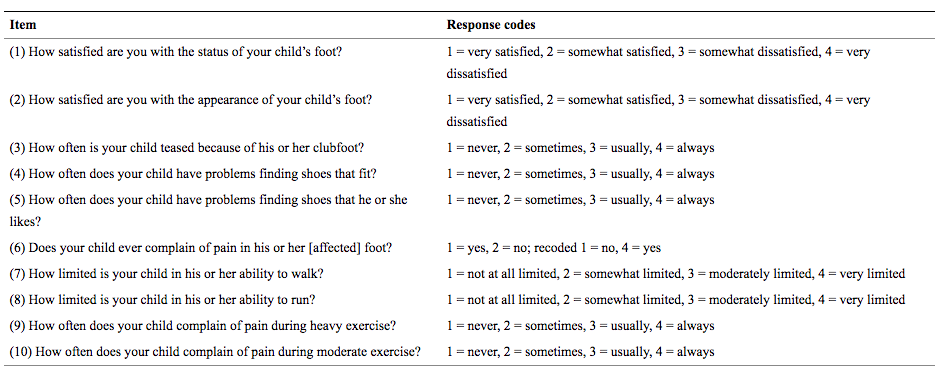Roye Score: Difference between revisions
Rachael Lowe (talk | contribs) mNo edit summary |
Rachael Lowe (talk | contribs) mNo edit summary |
||
| Line 5: | Line 5: | ||
</div> | </div> | ||
== Objective == | == Objective == | ||
The Roye Score<ref name=":0">Roye BD, Vitale MG, Gelijns AC, Roye DP Jr. [https://www.ncbi.nlm.nih.gov/pubmed/11176352/ Patient-based outcomes after clubfoot surgery.] J Pediatr Orthop. 2001 Jan-Feb; 21(1):42-9.</ref> is a 10-item disease-specific instrument to measure outcomes of treatment for [[Introduction to Clubfoot|clubfoot]]<ref name=":1"> | The Roye Score<ref name=":0">Roye BD, Vitale MG, Gelijns AC, Roye DP Jr. [https://www.ncbi.nlm.nih.gov/pubmed/11176352/ Patient-based outcomes after clubfoot surgery.] J Pediatr Orthop. 2001 Jan-Feb; 21(1):42-9.</ref> is a 10-item disease-specific instrument to measure outcomes of treatment for [[Introduction to Clubfoot|clubfoot]]<ref name=":1">Dietz FR, Tyler MC, Leary KS, Damiano PC. [https://www.ncbi.nlm.nih.gov/pmc/articles/PMC2664429/ Evaluation of a disease-specific instrument for idiopathic clubfoot outcome.] Clinical orthopaedics and related research. 2009 May 1;467(5):1256-62.</ref>. | ||
== Intended Population == | == Intended Population == | ||
Revision as of 12:03, 9 November 2017
Original Editor - Rachael Lowe
Top Contributors - Kim Jackson, Rachael Lowe, Simisola Ajeyalemi, Rucha Gadgil and Meaghan Rieke
Objective[edit | edit source]
The Roye Score[1] is a 10-item disease-specific instrument to measure outcomes of treatment for clubfoot[2].
Intended Population[edit | edit source]
This scale is intended for use by mothers of children with idiopathic clubfoot[2]. It can be used as an overall measure of clubfoot treatment outcomes with two distinct subscales: function and satisfaction[1].
Method of Use[edit | edit source]
This disease specific instrument consists of 10 items designed to measure treatment outcomes regarding overall satisfaction, appearance, pain, and physical limitations.
Reference[edit | edit source]
Roye BD, Vitale MG, Gelijns AC, Roye DP Jr. Patient-based outcomes after clubfoot surgery. J Pediatr Orthop. 2001 Jan-Feb; 21(1):42-9.
Evidence[edit | edit source]
Dietz et al[2] supported the use of the Roye Score as an outcome measure for idiopathic clubfoot in young children by providing evidence of its reliability, validity, and discriminatory power. They also found the Roye score to be sensitive to differences in treatment technique or underlying severity of disease.
References[edit | edit source]
- ↑ 1.0 1.1 Roye BD, Vitale MG, Gelijns AC, Roye DP Jr. Patient-based outcomes after clubfoot surgery. J Pediatr Orthop. 2001 Jan-Feb; 21(1):42-9.
- ↑ 2.0 2.1 2.2 Dietz FR, Tyler MC, Leary KS, Damiano PC. Evaluation of a disease-specific instrument for idiopathic clubfoot outcome. Clinical orthopaedics and related research. 2009 May 1;467(5):1256-62.







